Sustainable Low-Carbon Layout of Land around Rail Transit Stations Based on Multi-Modal Spatial Data
Abstract
:1. Introduction
- First, the basic distribution patterns of buildings near rail transit stations are classified according to the plane layout and facade layout, and the relationship between each distribution pattern and the nature of land use is analyzed. The sustainable low-carbon layout near rail transit stations can be analyzed more comprehensively.
- Second, combined with the agglomeration characteristics of different types of land use, the influence of different building distribution modes on the time of rail transit connection and distribution is analyzed. The time model of site gathering and distribution under different layout modes is established to establish the relationship between land-use distribution and carbon emission.
- Third, simulated cases were used to analyze the impacts of different building layouts on carbon emissions from multiple perspectives to support policy design and decision-making.
2. Literature Review
2.1. Research on the Development of the TOD Model
2.2. Research on Carbon Emissions of Urban Rail Transit
3. Methods
3.1. Research Framework
3.2. Traffic Mode Selection to Connect to Rail Transit Stations
- (a)
- Bus: Passengers are mainly a concentrated passenger flow, some passengers are not familiar with the regional situation and are carrying a lot of goods. In the center of the city, due to the large demand for public transport, they often form excessive congestions in the peak period, and because of the complex road conditions, the phenomenon of cross-car also occurs. Ordinary buses in the urban fringes have a limited passenger flow, large departure intervals and low efficiency. They not only waste transportation resources, but also cannot meet the needs of residents. The general community bus fare is low; except for the rush-hour passenger flow, when it is less, the operating loss is serious.
- (b)
- Car: In the center of the city it is more flexible than fixed-route transport such as buses because of the free choice of road sections, which allows to avoid congested areas. It can also greatly reduce the connection time but it is expensive. In the urban fringe areas, it is easy to operate more illegal vehicles, forming a larger security risk.
- (c)
- Non-motorized transport: The connection mode based on non-motorized transport is generally short in distance and passengers carry only a few items; this mode satisfies the shopping and leisure needs of travelers. Passengers tend to focus on road conditions and are susceptible to weather. Road safety, convenience and comfort are the main considerations for residents to travel slowly. Travel cost and time, travel habits and low carbon awareness are also influencing factors for residents to choose non-motorized transport.
3.3. Basic Mode of Building Distribution around Rail Transit Stations
3.4. Shortest Distance between Residential Point and Rail Transit Station
3.5. Site Distribution Time under Different Plane Layout Patterns
3.6. Carbon Emission under Different Building Distribution Modes
4. Results and Discussion
4.1. Parameter Settings
- (a)
- Quality and efficiency of public transport services: The quality and efficiency of public transport services in Shanghai are relatively high, but could be further improved, for example by increasing the number of public transport routes and enhancing the interchange experience, in order to increase the public’s use of public transport and reduce carbon emissions.
- (b)
- Traffic congestion and congestion: Shanghai has a relatively high level of traffic congestion and congestion, which can reduce the efficiency and quality of public transport services and lead to increased carbon emissions.
- (c)
- Public transport fares: Public transport fares in Shanghai are relatively low, but they are likely to rise gradually under growing economic pressures, which could have an impact on the public’s willingness to use them, leading to an increase in carbon emissions.
- (d)
- Urban planning and traffic management: Shanghai needs to develop appropriate urban planning and traffic management policies based on population density and traffic demand to ensure the efficient operation and quality of service of the public transport system.
- (e)
- New-energy public transport: As the promotion of new-energy vehicles and public transport in Shanghai continues to intensify, the usage rate and market share of new-energy public transport will gradually increase, which will help reduce carbon emissions.
4.2. Results and Discussion
5. Conclusions and Policy Implications
- (1)
- From the point of view of plane layout, the radial type (Type B) produces relatively fewer carbon emissions than the grid pattern (Type A). The reason is that the accessibility of the grid pattern is relatively poor, the traffic organization at the intersection is easy, and the nearby land is mostly residential land, with more slow traffic. The radial type facilitates bus trunk wiring and organization, shortening the distance to the city center.
- (2)
- From the perspective of vertical layout, the near-high far-low type (Type III) has the lowest carbon emissions, while the near-low far-high type (Type II) has the highest carbon emissions. It shows that the land development pattern around the station plays a direct role in the carbon emission of rail transit connections.
- (3)
- From the perspective of connection mode, the total carbon emissions generated by automobiles are much higher than those generated by buses. The construction of TOD cities will make the urban bus system more perfect and convenient. Under the condition that the development intensity around the site is getting higher and higher, this can not only facilitate the connection and travel of residents, but also effectively reduce the use of cars and reduce the carbon emissions of transportation.
Author Contributions
Funding
Institutional Review Board Statement
Informed Consent Statement
Data Availability Statement
Conflicts of Interest
References
- Van Fan, Y.; Perry, S.; Klemeš, J.J.; Lee, C.T. A review on air emissions assessment. Transportation 2018, 194, 673–684. [Google Scholar]
- International Energy Agency. 2019. Available online: https://www.iea.org/news/railways-could-provide-much-greater-benefits-for-energy-and-the-environment-according-to-iea-report. (accessed on 30 January 2019).
- Dorta Antequera, P.; Díaz Pacheco, J.; López Díez, A.; Bethencourt Herrera, C. Tourism, Transport and Climate Change: The Carbon Footprint of International Air Traffic on Islands. Sustainability 2021, 13, 1795. [Google Scholar] [CrossRef]
- Bouman, E.A.; Lindstad, E.; Rialland, A.I.; Stromman, A.H. State-of-the-art technologies, measures, and potential for reducing GHG emissions from shipping—A review. Transp. Res. Part D-Transp. Environ. 2017, 52, 408–421. [Google Scholar] [CrossRef]
- Wu, T.; Yan, J.W. Analysis on the influence of rail transit station Accessibility on travel choice. Archit. Cult. 2015, 10, 146–147. [Google Scholar]
- Zhang, N.Y.; Zhang, S.; Gao, Z.; Lu, G.; Li, J.; Jin, T.S. The influence of urban building layout on the diffusion characteristics of traffic pollutants in blocks. Environ. Sci. Technol. 2019, 12, 105–111+122. [Google Scholar]
- Rong, C. A Preliminary study on the development of Land Intensive Use around Chengdu Rail Transit TOD Station: A case study of the tracking evaluation of Luxiao Station. Mod. Urban Rail Transit 2021, 5, 7–12. [Google Scholar]
- Zhao, C.Q.; Ma, C.G.; Yu, Z.L.; Zhang, H.T. Research on the comprehensive development mode of land around rail transit station based on the concept of green Development: A case study of Zhichuang Eco-City in Guangyang Bay, Chongqing. Urban Archit. Space 2022, 6, 74–78. [Google Scholar]
- Wang, J.; Han, H.; Li, H.; He, S.M. Pradip Kumar Sharma, Lydia Chen, Multiple Strategies Differential Privacy on Sparse Tensor Factorization for Network Traffic Analysis in 5G. IEEE Trans. Ind. Inform. 2022, 18, 1939–1948. [Google Scholar] [CrossRef]
- Hu, Y.D.; Tao, S. The Evolution, Classification and Enlightenment of TOD Models in the U.S. Urban Transp. China 2018, 16, 34–42. [Google Scholar]
- Asriana, N.; Koerniawan, M.D. TOD Model through Low Carbon City Concept in Urban Design (case study: Palembang, Indonesia). IOP Conf. Ser. Earth Environ. Sci. 2020, 532, 012017. [Google Scholar] [CrossRef]
- Yi, D.; Luo, X.; Liang, D. An empirical study on transit-oriented low-carbon urban land use planning. Exploratory Spatial Data Analysis (ESDA) on Shanghai, China. Habitat Int. 2016, 53, 379–389. [Google Scholar]
- Xu, C.; Haase, D.; Su, M.; Yang, Z. The impact of urban compactness on energy-related greenhouse gas emissions across EU member states: Population density vs. physical compactness. Appl. Energy 2019, 254, 113671. [Google Scholar] [CrossRef]
- Loo, B.P.; du Verle, F. Transit-oriented development in future cities: Towards a two-level sustainable mobility strategy. Int. J. Urban Sci. 2017, 21, 54–67. [Google Scholar] [CrossRef]
- Holz-Rau, C.; Scheiner, J. Land-use and transport planning—A field of complex cause-impact relationships. Thoughts on transport growth, greenhouse gas emissions and the built environment. Transp. Policy 2019, 74, 127–137. [Google Scholar] [CrossRef]
- Makido, Y.; Dhakal, S.; Yamagata, Y. Relationship between urban form and CO2 emissions: Evidence from fifty Japanese cities. Urban Clim. 2012, 2, 55–67. [Google Scholar] [CrossRef] [Green Version]
- Wang, X.Q.; Shao, C.F.; Yin, C.Y.; Dong, C.J. Exploring the effects of the built environment on commuting mode choice in neighborhoods near public transit stations: Evidence from China. Transp. Plan. Technol. 2021, 44, 111–127. [Google Scholar] [CrossRef]
- Ye, Y.Y.; Zhang, H.O.; Xu, X.Q.; Wu, Q.T. Urban spatial structure for low-carbon transportation: Theory, model and case. Urban Plan. Forum. 2012, 5, 37–43. [Google Scholar]
- Zhang, C.; Jia, F.J. Urban Transportation carbon emission characteristics and energy-saving emission reduction strategies based on resident travel. Traffic Transp. 2020, 36, 76–79. [Google Scholar]
- Li, Y.M.; Shen, Y.S.; Wang, S.H. Spatial and temporal characteristics and effects of terrestrial carbon emissions based on land use change in Anhui Province. J. Soil Water Conserv. 2022, 36, 182–188. [Google Scholar] [CrossRef]
- Zhang, J.Y.; Zhong, S.Q.; Wang, T. Blockchain-Based Systems and Applications: A Survey. J. Internet Technol. 2020, 21, 1–14. [Google Scholar]
- Wang, J.; Yang, Y.Q.; Wang, Y.; Sherratt, S.; Zhang, J.Y. Big Data Service Architecture: A Survey. J. Internet Technol. 2020, 21, 393–405. [Google Scholar]
- Rong, P.J.; Zhang, L.J.; Liu, L.Z. Study on spatial differentiation of daily travel carbon emissions of urban households in Kaifeng. Resour. Sci. 2018, 40, 1307–1318. [Google Scholar]
- Wang, H.H.; Zeng, W.H. Revealing Urban Carbon Dioxide (CO2) Emission Characteristics and Influencing Mechanisms from the Perspective of Commuting. Int. J. Syst. Sci. 2019, 11, 385. [Google Scholar] [CrossRef] [Green Version]
- Shen, X.P. Calculation Theory and Application of Carbon Emission Reduction in Urban Rail Transit: A Case Study of Beijing. Ph.D. Thesis, Beijing Jiaotong University, Beijing, China, 2018. [Google Scholar]
- Zhao, R.Q.; Fan, Y.; Zhang, Z.J. Impact of urban subway on carbon emission of commuter traffic of residents along the line—A case study of Zhengzhou City. Areal Res. Dev. 2021, 40, 151–155. [Google Scholar]
- Suresh, J.; Vaishnavi, B. Health impact assessment of auto rickshaw and cab drivers due to exposure to vehicular pollution in Delhi: An integrated approach. Environ. Sci. Pollut. Res. Int. 2021, 29, 5124–5133. [Google Scholar]
- Hafezi, M.H. Modelling transport-related pollution emissions for the synthetic baseline population of a large Canadian university. Int. J. Urban Sci. 2019, 23, 519–533. [Google Scholar] [CrossRef]
- Tan, X.C.; Tu, T.Q.; Gu, B.H. Assessing CO2 Emissions from Passenger Transport with the Mixed-Use Development Model in Shenzhen International Low-Carbon City. Land 2021, 10, 137. [Google Scholar] [CrossRef]
- Wang, H.H.; Yu, H.Q.; Zeng, W.H. Research on the potential of traffic carbon emission reduction in Beijing based on the adjustment of separation of work and residence. China Popul. Resour. Environ. 2018, 28, 41–51. [Google Scholar]
- Sun, Y. Relationship between Urban Form and Carbon Emissions: A Cross-Sectional Empirical Study of 282 Prefecture-Level Cities in China. Master’s Thesis, Zhejiang University, Zhejiang, China, 2021. [Google Scholar]
- Man, Z.; Zhao, R.Q.; Yuan, Y.C. Influence of land mixing degree around urban residential areas on carbon emission from commuter traffic—A case study of typical residential areas in Jiangning District, Nanjing. Hum. Geogr. 2018, 33, 70–75. [Google Scholar]
- Dai, L.D.; Zhou, R.; Zhang, F.E. Study on the impact of urban land use on residents' commuting carbon emission. Resour. Environ. Yangtze Basin 2016, 25, 68–77. [Google Scholar]
- Song, L.L.; Monteil, J.; Ygnace, J.-L.; Rey, D. Incentives for Ridesharing: A Case Study of Welfare and Traffic Congestion. J. Adv. Transp. 2021, 2021, 6627660. [Google Scholar] [CrossRef]
- Jiang, Y.; He, D.Q. ZEGRAS Christopher. Study on the impact of urban block shape on residential travel energy consumption. Urban Commun. Commun. 2011, 9, 21–29+75. [Google Scholar] [CrossRef]
- Man, C.; Zhao, R.Q.; Yuan, Q.C.; Feng, D.X.; Yang, Q.L.; Wang, S.; Yang, W.J. Effects of land mixing degree on commuting traffic carbon emission: A case study of Jiangning District, Nanjing. Humanit. Sci. 2018, 1, 70–75. [Google Scholar] [CrossRef]
- Xie, Y.; Chen, X.J.; Zhang, J. Study on the Optimal plot ratio of urban Residential Land from the perspective of energy conservation. In China Society of Urban Planning, Dongguan Municipal People's Government. Rational Planning for Sustainable Development, Proceedings of the 2017 China Urban Planning Annual Conference; Urban Planning Society of China, Ed.; China Building and Construction Press: Beijing, China, 2017; pp. 26–36. [Google Scholar]

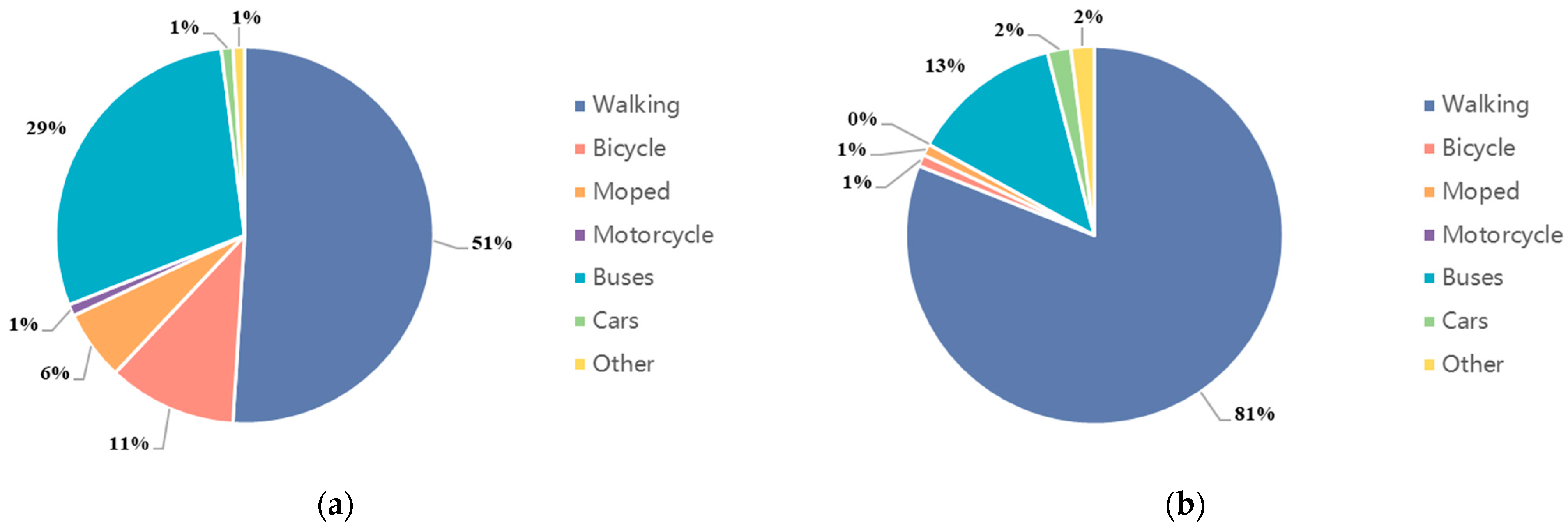



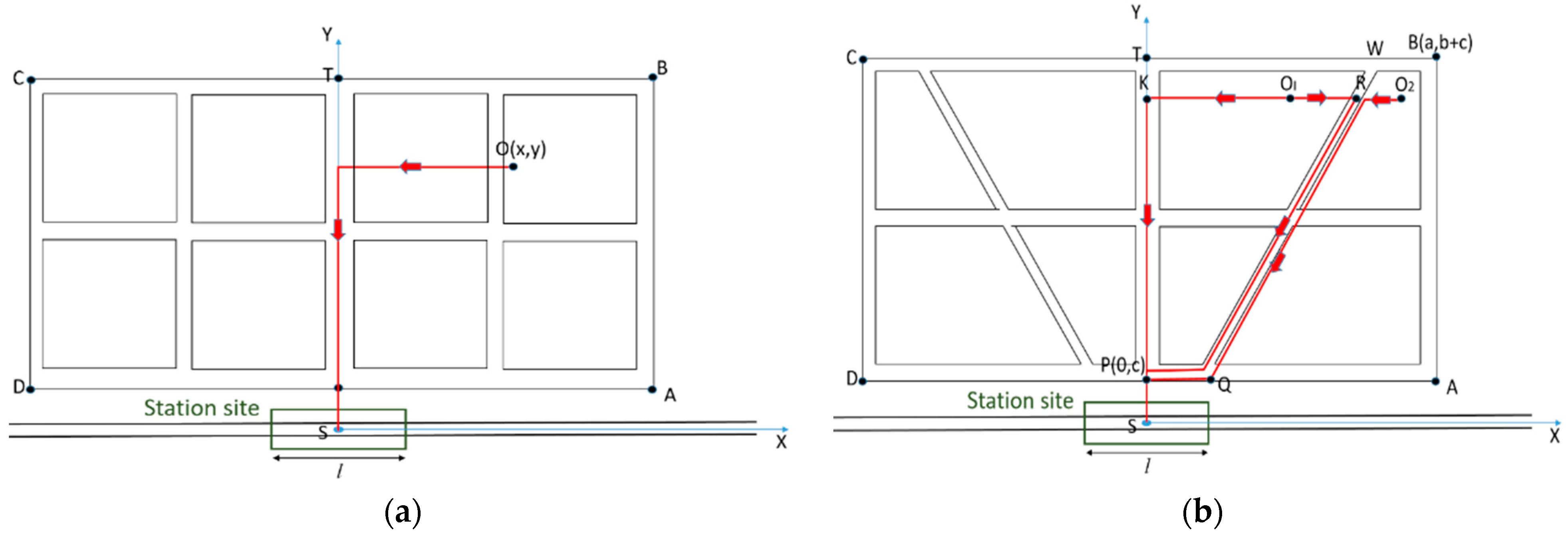

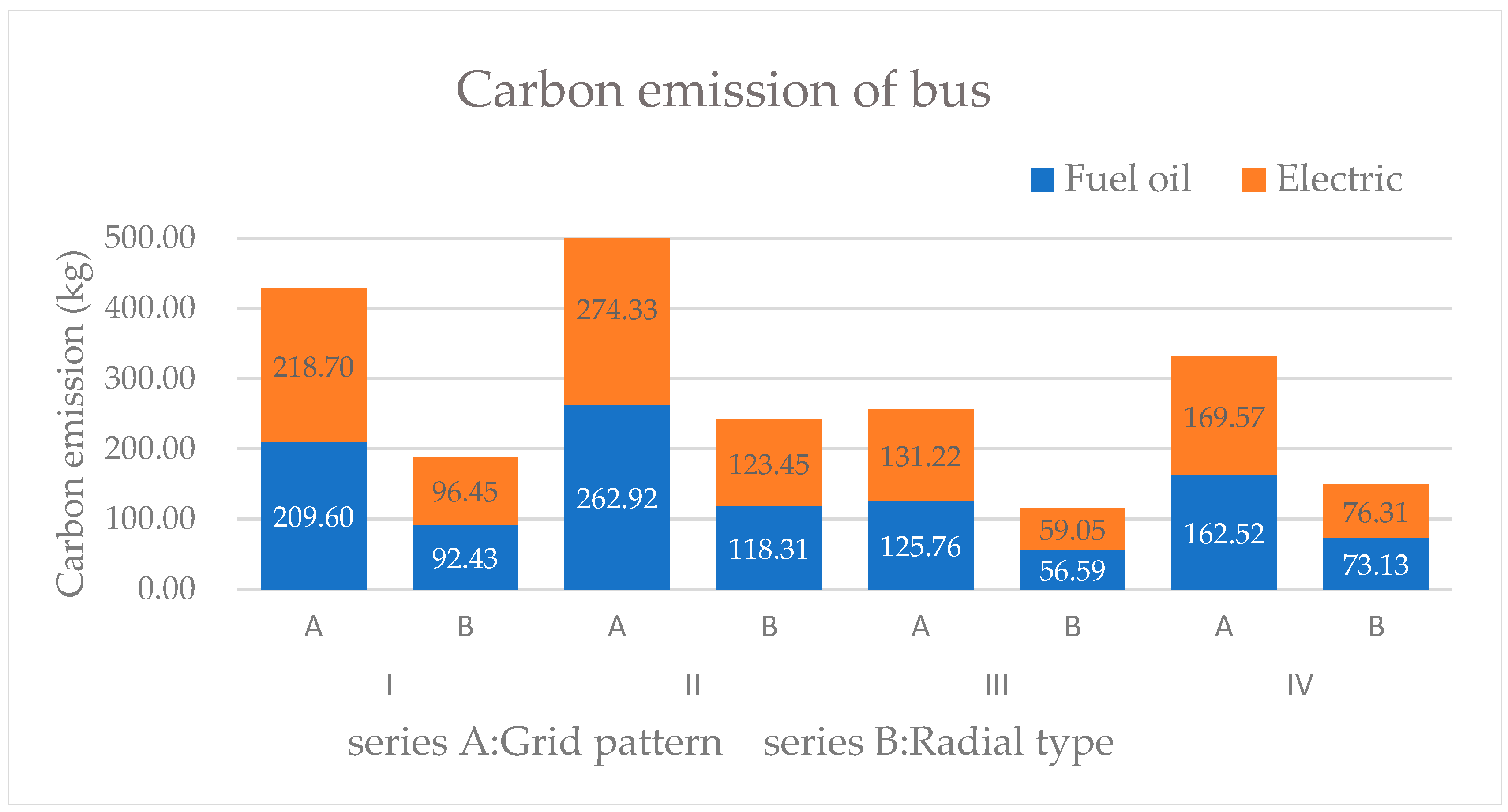
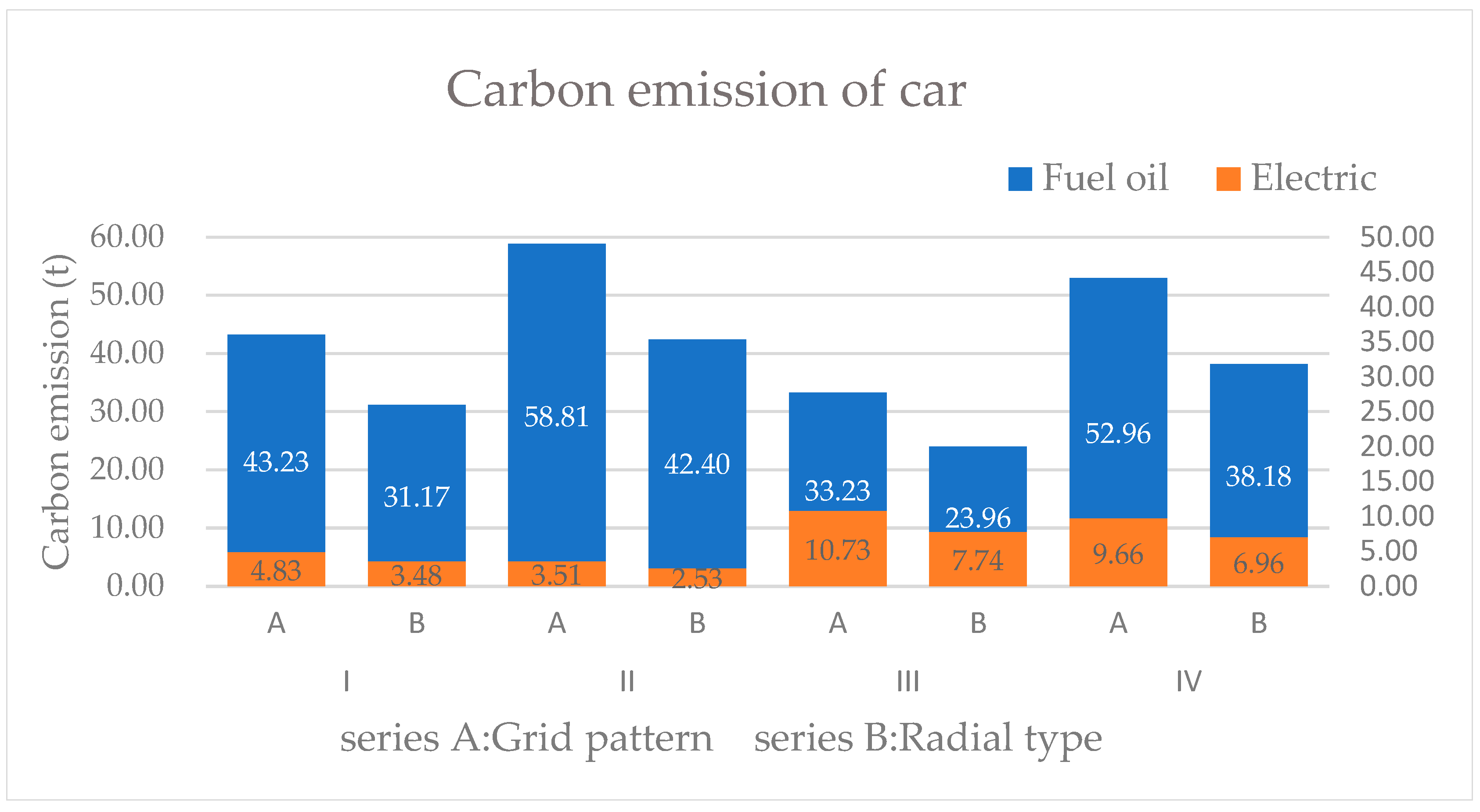

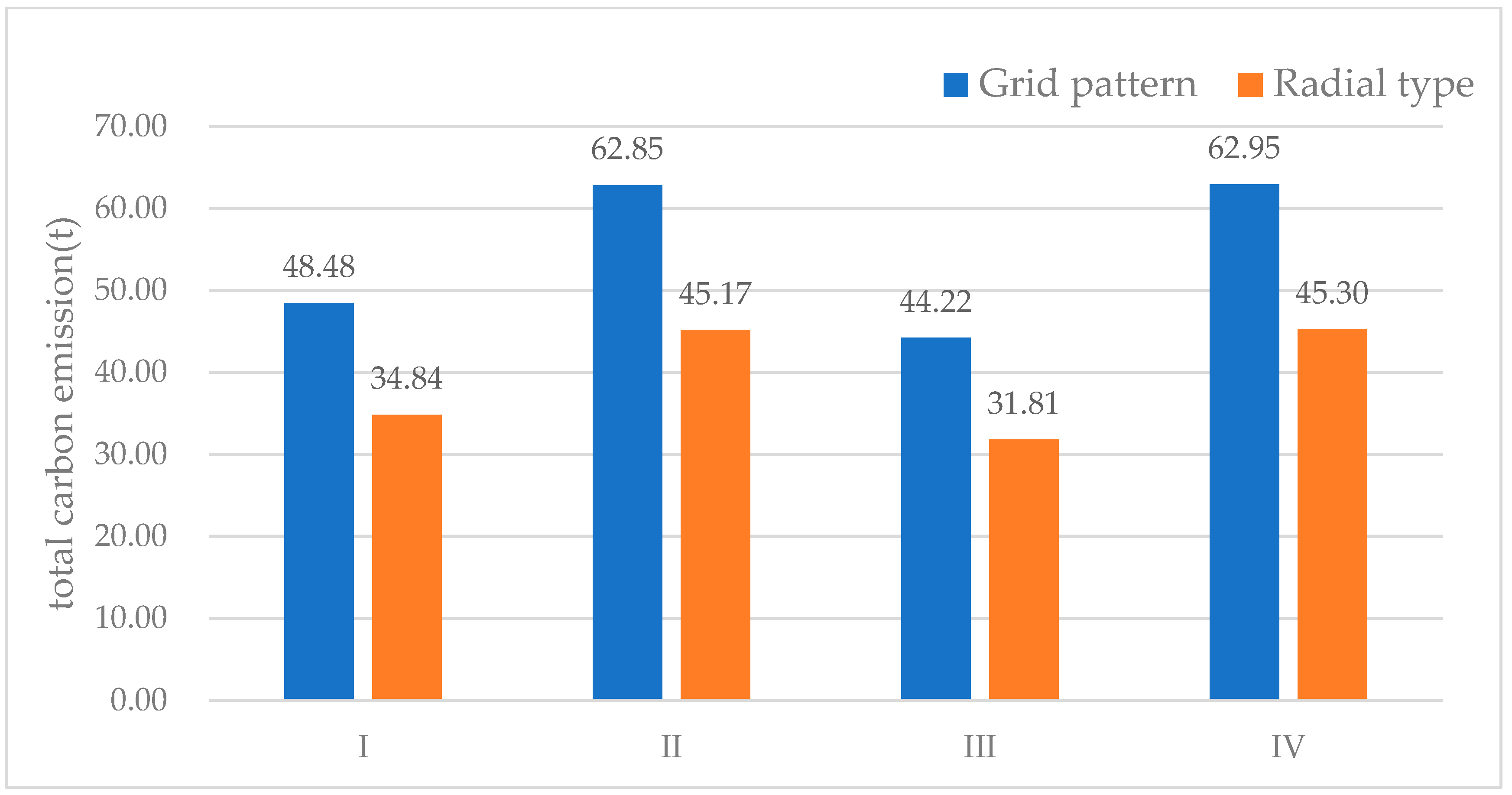
| Parameter | a (km) | b (km) | c (m) | l (m) | u (m2/person) | v (km/h) |
|---|---|---|---|---|---|---|
| Value | 2 | 2 | 25 | 120 | 30 | 40 |
| Type I | Type II | Type III | Type IV |
|---|---|---|---|
| 1 | 1.4 | 0.6 | 0.9 |
| Type I | Type II | Type III | Type IV | |
|---|---|---|---|---|
| Walk | 47% | 22% | 75% | 50% |
| Bicycle | 33% | 53% | 18% | 37% |
| Bus | 14% | 16% | 5% | 8% |
| Car | 6% | 9% | 2% | 5% |
| Vehicle Structure | Type I | Type II | Type III | Type IV | |
|---|---|---|---|---|---|
| Bus | Fuel oil | 35% | 35% | 35% | 35% |
| Electric | 65% | 65% | 65% | 65% | |
| Car | Fuel oil | 86% | 92% | 68% | 79% |
| Electric | 14% | 8% | 32% | 21% |
| Traffic Mode | Fuel Type | Layout Format | Unit Energy Consumption | Carbon Emission Coefficient | Oil Conversion Coefficient | Speed | Share Ratio | Carrying Coefficient |
|---|---|---|---|---|---|---|---|---|
| Bus | Fuel oil | |||||||
| Grid pattern | 0.4 | 2.13583 | 1.15 × 10−3 | 20 | 12 | 15 | ||
| Radial type | 9 | |||||||
| Electric | W (KWh/km) | / | ||||||
| Grid pattern | 0.6 | 0.92 | / | 20 | 12 | 15 | ||
| Radial type | 9 | |||||||
| Car | Fuel oil | |||||||
| Grid pattern | 0.088 | 2.13583 | 1.07 × 10−3 | 40 | 4.5 | 1.2 | ||
| Radial type | 3.7 | |||||||
| Electric | W (KWh/km) | / | ||||||
| Grid pattern | 0.15 | 0.92 | / | 40 | 4.5 | 1.2 | ||
| Radial type | 3.7 |
| Carbon Emissions of Buses (t) | Carbon Emission Category Land Use Mode | Gridpattern | Radial Type | ||||||
| AI | AII | AIII | AIV | BI | BII | BIII | BIV | ||
| Fuel oil | 0.21 | 0.26 | 0.13 | 0.16 | 0.09 | 0.12 | 0.06 | 0.07 | |
| Electric | 0.22 | 0.27 | 0.13 | 0.17 | 0.10 | 0.12 | 0.06 | 0.08 | |
| Total | 0.43 | 0.54 | 0.26 | 0.33 | 0.19 | 0.24 | 0.12 | 0.15 | |
| Carbon Emissions of Cars (t) | Carbon Emission Category Land Use Mode | Gridpattern | Radial Type | ||||||
| AI | AII | AIII | AIV | BI | BII | BIII | BIV | ||
| Fuel oil | 43.23 | 58.81 | 33.23 | 52.96 | 31.17 | 42.40 | 23.96 | 38.18 | |
| Electric | 4.83 | 3.51 | 10.73 | 9.66 | 3.48 | 2.53 | 7.74 | 6.96 | |
| Total | 48.06 | 62.32 | 43.96 | 62.62 | 34.65 | 44.93 | 31.69 | 45.15 | |
Disclaimer/Publisher’s Note: The statements, opinions and data contained in all publications are solely those of the individual author(s) and contributor(s) and not of MDPI and/or the editor(s). MDPI and/or the editor(s) disclaim responsibility for any injury to people or property resulting from any ideas, methods, instructions or products referred to in the content. |
© 2023 by the authors. Licensee MDPI, Basel, Switzerland. This article is an open access article distributed under the terms and conditions of the Creative Commons Attribution (CC BY) license (https://creativecommons.org/licenses/by/4.0/).
Share and Cite
Liu, W.; Zhang, J.; Jin, L.; Dong, J.; Alfarraj, O.; Tolba, A.; Wang, Q.; He, Y. Sustainable Low-Carbon Layout of Land around Rail Transit Stations Based on Multi-Modal Spatial Data. Sustainability 2023, 15, 9589. https://doi.org/10.3390/su15129589
Liu W, Zhang J, Jin L, Dong J, Alfarraj O, Tolba A, Wang Q, He Y. Sustainable Low-Carbon Layout of Land around Rail Transit Stations Based on Multi-Modal Spatial Data. Sustainability. 2023; 15(12):9589. https://doi.org/10.3390/su15129589
Chicago/Turabian StyleLiu, Weiwei, Jin Zhang, Liang Jin, Jieshuang Dong, Osama Alfarraj, Amr Tolba, Qian Wang, and Yihao He. 2023. "Sustainable Low-Carbon Layout of Land around Rail Transit Stations Based on Multi-Modal Spatial Data" Sustainability 15, no. 12: 9589. https://doi.org/10.3390/su15129589






